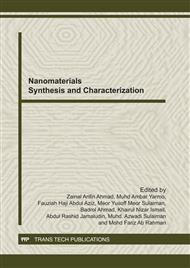p.317
p.322
p.327
p.333
p.338
p.344
p.348
p.353
p.359
Preparation and Characterization of Carbon Nanotube-Based Electrochromic Material
Abstract:
Electrochromic devices (ECD) change light transmission properties in response to voltage during electrochemical redox process. Conducting polymer like polyaniline (PANI) is considered as a good electrochromic material, however, its still exhibit substantial resistivity due to lack of conducting pathway. This paper describes the study in developing electrochromic material that will exhibit higher conductivity by using carbon nanotubes (CNTs) as the filler. Preparation of electrochromic material on FTO glass substrate was done by electrochemical process using mixture of CNTs and PANI in H2SO4. SWCNTs were characterized by Raman spectroscopy. PANI and PANI/CNTs films produced were then characterized using SEM and Hall Effect measurement. From Raman spectroscopy, raw SWCNTs have a typical diameter of 1.3 nm and have good crystallinity with the ratio of 0.12. Increasing the voltage of deposition of PANI, from 1.1–1.7 V, will resulting in increasing the thickness of PANI film from 11‒19 μm. PANI/CNT film was recorded to have higher conductivity than PANI film by 5–7%. From the study, higher conductivity of PANI/CNT film can be achieved by using deposition parameter of 1.3 V for 5 minutes.
Info:
Periodical:
Pages:
338-343
Citation:
Online since:
October 2011
Price:
Сopyright:
© 2012 Trans Tech Publications Ltd. All Rights Reserved
Share:
Citation:


